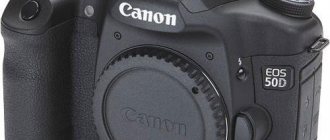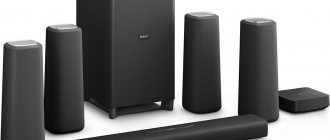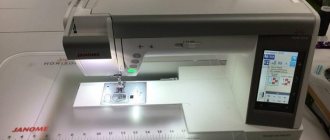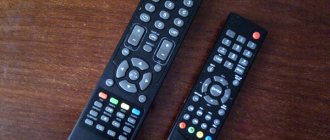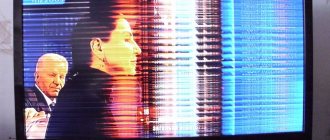Checking a TV when purchasing is not an easy task. Given the large selection of models and range of manufacturers, the matter must be taken seriously. During the purchase, there may be many controversial situations between the seller and the client in the form of minor scratches or defects that are not considered defective. Useful tips on how to choose a TV will be described below.
The purchase must proceed according to plan:
- viewing ratings and reviews about the manufacturer;
- determining the price category;
- checking the completeness of equipment;
- examining the screen for dead pixels;
- conducting a glare test;
- listening to speakers.
Important! After reading positive reviews, you should not be completely confident in the quality of the equipment. No well-known person is insured against marriage src=”https://otvet.tv/wp-content/uploads/2019/09/01-DNOG6UDE1AdPkYZpRj07Pp5d4WA.jpg” class=”aligncenter” width=”660″ height=”371″[ /img]
Visual inspection
You can tell a lot from the packaging, namely, in what condition the equipment arrived at its destination. The buyer has the right to demand that the goods be opened before his eyes . The box should be:
- not opened;
- not shabby;
- not swollen (from moisture).
After removing it from the box, you need to check the TV. All panels must be intact, without scratches or chips. Particular attention should be paid to polished panels. They are more susceptible to damage than others.
After opening the package, the following is checked:
- TV;
- components (remote control, passport, cords);
- protective film on panels, screen and stand.
Note! A good sign that the equipment has not been used is the absence of dust after opening the package.
Each manufacturer has its own set of accessories. For example, Samsung supplies TVs of the UE43M5513AUXRU model range with an adapter for hanging on the wall. The list of additions is indicated in the document attached to the equipment. You can safely demand them from the seller. After a visual inspection, you should begin checking the functionality.
So what should you pay attention to?
First of all, make sure that the TV was stored in normal conditions and was not knocked or dropped.
- Take a look at the packaging. Is the box intact? Are there any traces of moisture?
- Inspect the device body. There should be no dents, scratches or other damage on the surface.
- Check the screws that secure the back panel.
- Make sure there is a protective film on the screen.
- Check the list of components (cords, remote control, etc.). A complete list is usually given in the instructions. Don't forget about the warranty card.
If the visual inspection is successful, ask the seller to turn on the TV.
It’s definitely worth assessing the image quality before purchasing. See also -
How to choose a TV for your home: expert advice
Checking for dead pixels
To check the TV for dead pixels when purchasing, you should turn on the equipment. At the same time, pay attention to how long the screen lights up. The standard connection mode for LG TVs is 10 seconds.
A dead pixel can look different: it can be either a completely black dot on the screen when the screen is turned on, or simply an area with incorrect color display . To understand this, let's look at the pixel design. It is formed from 3 colors: green, blue and red. If none of them work, a black dot will appear on the screen. You can detect the problem by carefully examining the test pictures. They use either images built into the TV shell or downloaded to a flash drive. A partially defective pixel is more difficult to identify. You can identify it with patterned, mesh, and curly pictures. LG OLED TVs with 4K display are tested this way.
Important! By the standards of the manufacturer and seller, a certain number of dead pixels is not considered defective. But the buyer always has the right to check and ask for the model with the smallest number.
Checking the TV before purchasing.
When buying a TV, there is a need to protect yourself from unpleasant surprises. Checking your TV more thoroughly can protect you from such surprises. Let's look at some procedure for checking a TV that can be done in a store. The main goal is that you yourself should see a working TV and evaluate the image quality.
Inspection of appearance.
First, you need to check the packaging for various damages (tears, dents, etc.). During transportation, the packaging often receives blows, and the TV also takes a fair amount of damage. Next, check the presence and correctness of filling out all documents: product passport, warranty card. Pay attention to the warranty card; the seller must fill it out correctly: serial number of the product, date of sale, warranty period, stamp in the right place.
Take the TV out of the packaging and check its appearance. Also don't forget to check the remote control. During an external inspection, look for cracks, chips, abrasions, etc. It is necessary to check the screws for signs of tampering; if there are any, then your TV has already been sold and most likely was being repaired.
After an external inspection, you can start connecting the TV and check its operation, the operation of the remote control and operation with external devices, such as a digital set-top box, a USB drive, etc. You can prepare a USB flash drive in advance by recording a high-quality video clip and an image on it to check for dead pixels.
Pictures to check the image -
To check Ultra HD 4K TVs -
Checking your TV for dead pixels.
When choosing a TV in a store, it is not easy to determine the presence of dead pixels on the TV screen by eye. But you can still try.
According to the standards, a certain number of non-working pixels is allowed. Different rules allow different numbers of defective pixels. Therefore, when you come home and discover this defect, you will not be able to return or replace the TV in the store. It is better to check and detect this malfunction before purchasing.
In order to check the matrix of a new TV for the presence of dead pixels, it is necessary to display solid colors one by one on the screen. For example, if you are looking for black dots, then display a white background. If you are looking for a white point, then display a black background, and so on. If you carefully look at the entire TV screen, then if there is a dead pixel, it will be visible to the naked eye, but you can also use a magnifying glass.
Defective pixels visible on screen
Checking an LCD TV for defective (dead) pixels involves carefully examining the working screen using test colors that we previously loaded onto a USB flash drive. We connect the flash drive to the USB port and inspect the LCD screen sequentially using the control panel and selecting the primary colors: black, white, red, green, blue, cyan, purple and yellow.
Defects may appear that only appear when the TV matrix heats up. You can identify them after the TV has been running for a while.
There are also pixels that do not work correctly when neighboring sub-pixels are working. You can detect such a drawback if you apply a grid, gradation, color stripes or checkerboard-shaped fill to the TV screen.
Uneven screen backlight.
When a picture of the same color appears on the screen, i.e. the screen will be one color. This color should be on the screen without any shades, tints, etc. But in the manufacture of backlit LCD displays, due to the technological features of manufacturing, it is difficult to achieve completely uniform illumination. Therefore, your goal is to check the uniformity of the color field before purchasing a TV. However, such a defect is not a breakdown or malfunction and such a TV cannot be returned or exchanged.
Defects on the screen are called TINT, BANDING, FLASH.
TINT is translated as “tint” or “color background”; it indicates how correctly the white color is reproduced on the screen. When watching any movie, you will not be able to see this defect. But when you turn on a static white picture, this interference will greatly interfere with normal viewing.
To detect such interference on the TV, you must turn on a white or gray background. And if stripes, spots of various shapes, painted in a different background are noticeable, this may indicate the presence of a TINT defect.
Clearly expressed TINT
TINT within acceptable limits
BANDING on the TV screen can be seen in the form of stripes of a different shade. During normal TV viewing, it can be noticeable in uniform areas when moving the camera. To detect such a defect, apply a field of any uniform color to the screen.
Unacceptable degree of BANDING
GLARS usually appear on LED TVs. To detect glare on a TV screen, you need a completely dark room. In addition, when checking the TV, it is necessary to select the maximum backlight level, turning off all modes that affect the adjustment and improvement of the backlight level. To detect highlights, you need to present a black picture with bright elements on the screen, for example, titles on a black background. Then, from a certain distance, identify the highlights that may appear at the edges of the screen. Of course, some minimal highlights are acceptable for normal viewing.
High level of glare
It will not be possible to choose a TV completely without any defects, but it is within your power to try and find a TV model with minimal defects.
7, total, today
I liked it! Share with your friends.
Checking for highlights, tint and banding
When the screen is on, but with a black screensaver, pay attention to the glare. They can be located in different areas of the TV. On LCD TVs, spots are very noticeable.
Important! If in the store, during testing, glare was detected on the display, you need to request an exchange of the model.
The spots can be of different colors: pink or green. The technical name for this problem is tint. Coloring occurs due to the overlapping of images on top of each other in the matrix.
Banding is the manifestation of stripes of different shades. It is noticeable in homogeneous areas. For testing, you can use media with a monochromatic test image.
TV equipment
After opening the package, you must check the contents of the TV according to the attached instructions. The kit must include a remote control, a leg with bolts, connection cables and 3D glasses, if the TV has the corresponding function. In addition, you need to make sure that you have all the necessary documents: a technical passport of the device, a receipt, operating instructions and a completed warranty card. Moreover, the serial number in the latter must match the number on the TV.
Pencil test
TVs with 100 Hz are considered high-quality and harmless models. frequency. They do not impair vision during viewing and do not cause headaches. If you do not find such information in the documents attached to the equipment, or you simply have doubts about the accuracy of the characteristics, you can check the frequency yourself:
- display a bright picture on the screen;
- With a long object, draw a circle shape at a 15 centimeter distance from the screen.
Result:
- no contours appeared on the display - high-quality TV.
- if flickering appears in the form of a circle, this technique will tire the eyes.
Checking the contents
Examine the equipment package according to the documents and check the presence of everything listed. After purchase, it will be difficult to prove that the missing item was not originally included in the kit. And even if you prove it, due to bureaucratic delays, it may take a lot of time to get the missing component.
So, most often the LCD panel kit includes:
- technical certificate;
- warranty card;
- remote control;
- corresponding cables;
- stand or bracket for hanging.
Particular attention should be paid to the warranty book (coupon), because the possibility of exchange depends on their correct completion. This document should contain:
- serial number of the TV panel (it must be checked with that indicated on the TV body);
- model name;
- date of purchase;
- seller's signature;
- store seal.
And, of course, the above must be accompanied by a purchase receipt.
Acceptable quantity
How many dead pixels are acceptable? The answer to this question is contained in the international quality standard for LCD TVs ISO 13406-2. It defines 3 types of defective points:
- Open or white - such pixels freeze in the open state and constantly glow white.
- Closed or black - such pixels freeze in a closed state and constantly glow black.
- Colored - the control transistor of such pixels fails, and they constantly light up in one of 3 colors: red, green or blue.
LCD devices are also divided into 4 classes. The first class is the highest; the matrix of devices of this class does not allow the presence of defective points at all. The bulk of devices on the market are second class. The standard defines the permissible number of defective points of various types depending on the maximum resolution that it supports. Information for popular class 2 devices is given in the table below.
| pixel type \max resolution | 1280x720 (720p, HD Ready) | 1920x1080 (1080p, Full HD) |
| 1. White | 2 | 4 |
| 2. Black | 2 | 4 |
| 3. Colored | 5 | 10 |
| TOTAL | 9 | 18 |
Checking the connectors
It would also be a good idea to test the operation of the connectors available on the TV. The easiest way to check USB is by connecting a USB flash drive to it. If there are several such ports, it is better to play it safe and test them all one by one.
HDMI connectors can be checked directly in the store, since almost all of them have demonstration stands that allow you to display images on display windows. If the selected TV has several HDMI connectors, then you need to ask the seller to insert the cable into all of them one by one.
The headphone jack can be checked by connecting a regular headset from a smartphone, or wireless headphones, which will also allow you to test the operation of the Bluetooth connection.
Checking the antenna input directly in the store can be problematic; it is unlikely that you can find antennas for sale anywhere. This can only be done at home by connecting the home antenna to the TV tuner socket.
Recovery
There are several methods for repairing dead pixels found during the test. They give results extremely rarely and only in correcting colored dots (type 3). Tests also show that this usually helps only for a short time; the next day the pixel fails again. In addition, you can easily spoil neighboring points. Therefore, we strongly do not recommend doing restoration, but we will still consider the methods:
- Programmatic approach. A matrix image is displayed on the screen, in which dots of different colors are randomly displayed. Within 20 minutes, the problematic pixel should recover;
- Mechanical approach. Turn off the TV, use a napkin to press on the dead pixel with your finger, turn on the device and stop pressing. This method can harm the matrix.
Therefore, we do not advise you to try to recover pixels yourself . Firstly, there will be practically no sense, and secondly, you can only make things worse. It will be much better if you check the TV before purchasing, so that you don’t have to prove to the store that this is a warranty issue. After all, now you can do it yourself and for free, thanks to this article. Below you can watch the video test, which is in the archive, and also check your monitor for dead pixels by expanding the video to full screen. Don't forget to select 720p(HD) quality in the player settings.
Detecting color spots and checking illumination uniformity
In addition to checking for dead pixels, before purchasing a TV, you need to check for stains, and also evaluate whether the backlight of its screen is uniform. To do this, you will also need a one-color image, which must be displayed on the TV receiver screen. When broadcasting, the display should not have different shades of different colors. That is, the screen must be uniform. However, LSD displays have some technological features that make it very difficult to achieve this uniformity. Therefore, manufacturing companies do not consider such a defect to be a sufficient reason to return the product. Such problems with highlighting and spots are called tint, banding and highlights.
- Tint is the various streaks that appear when white color is not displayed correctly along the edges of the screen. To identify this defect, you need to use a gray image. If greenish or pink stripes appear, then this problem exists. During normal TV viewing, the tint is not noticeable. However, it may cause inconvenience when viewing photos or playing games;
- Glare. With this defect, the device display is illuminated differently. In different parts of it the intensity of illumination is different. When purchasing, it is unlikely that such a fault will be detected, since this requires a dark room. However, if the differences are small, this will not interfere with viewing;
- Banding. Like tint, this malfunction is characterized by the presence of color stripes that differ in shade from the main color of the picture. They become visible when filling a single-color image;
All these defects are not a breakdown. There are practically no LSD TVs that do not have them. However, they can be of varying intensity, which should be checked when purchasing a TV receiver.
